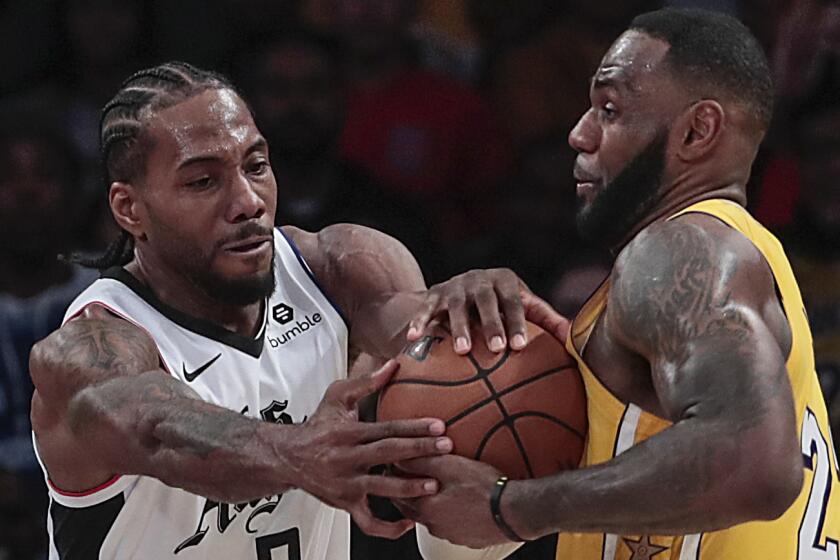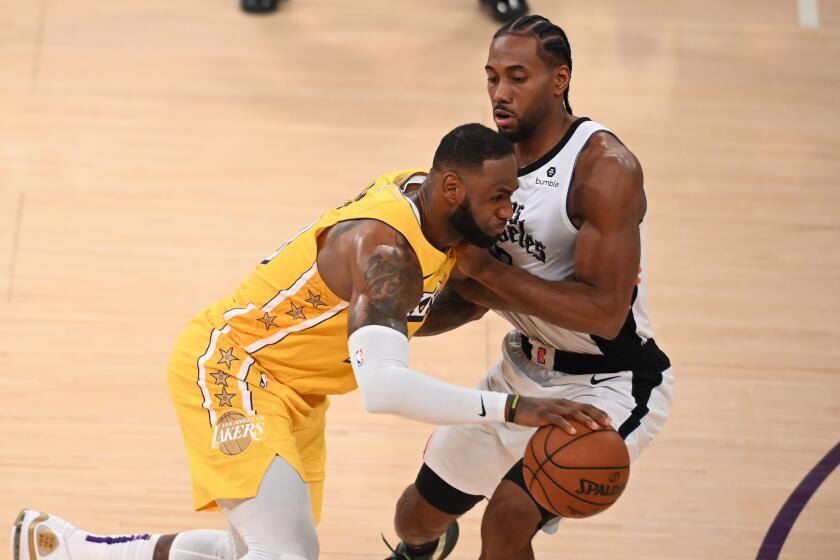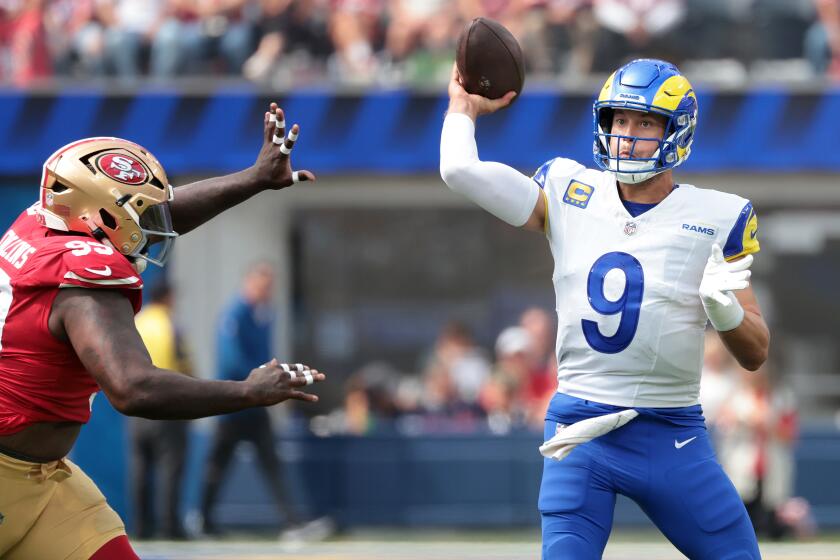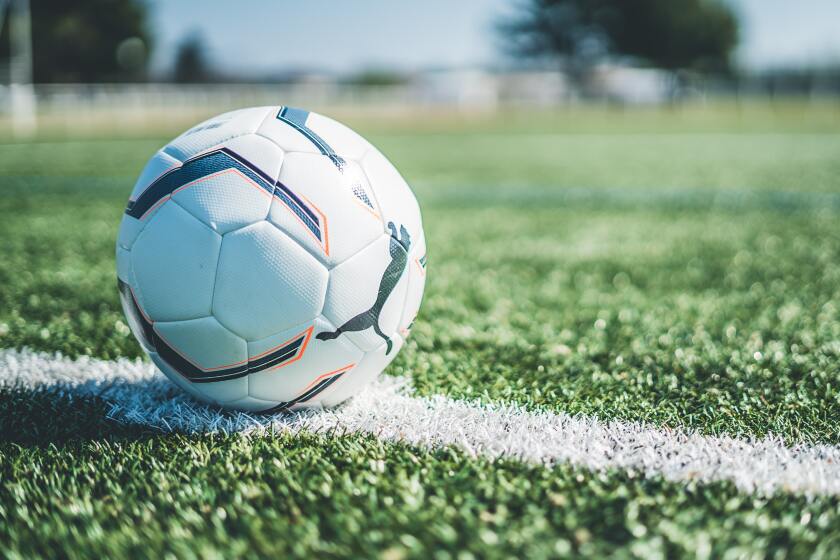Column: Are free throws really ‘free’? It’s probably the hardest shot for players
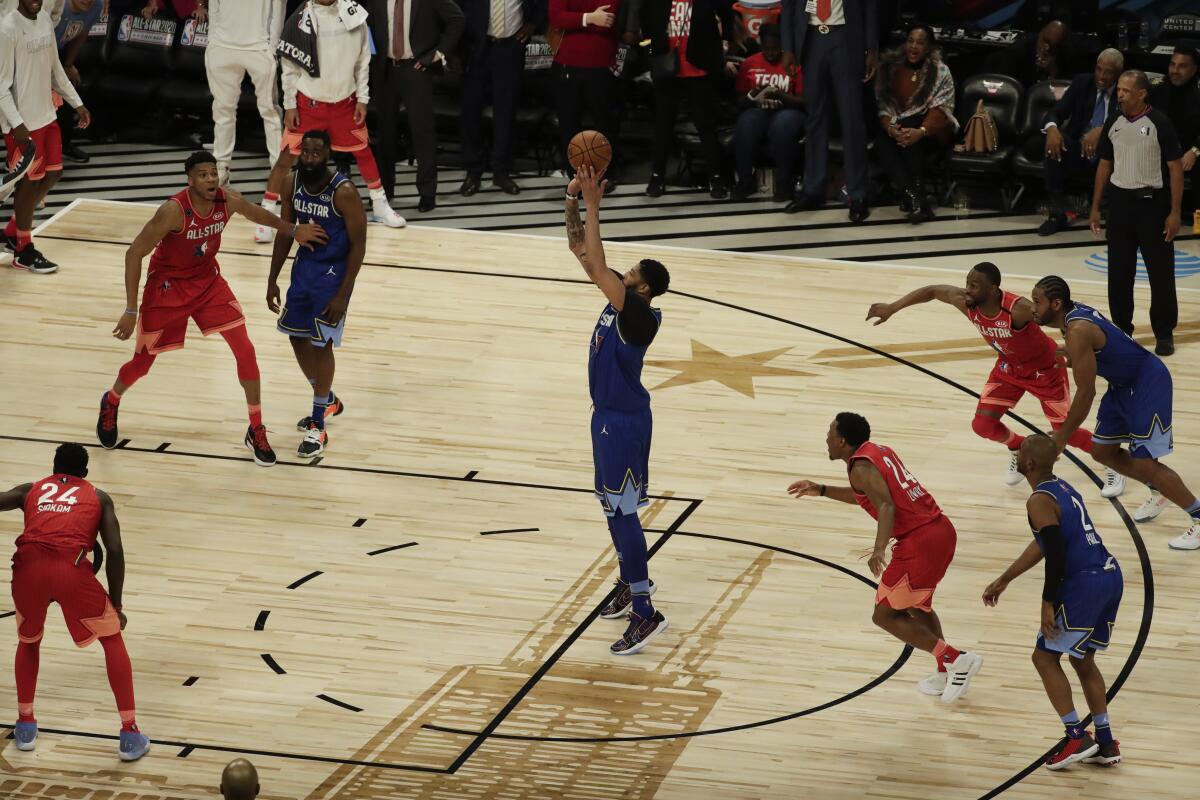
- Share via
Is there a greater misnomer in all of sports than the phrase “free throw”? Yeah, sure there isn’t anyone in front of the shooter but that doesn’t mean they aren’t being guarded. In fact, one could argue they are trying to score against their toughest opponent.
“The game really is 90% mental and 10% physical,” said Lakers assistant coach Phil Handy. “People really don’t understand that. You can practice and practice and practice but if you’re not mentally strong … it all can crumble.”
Paging Nick Anderson. It has been 25 years since he famously missed four consecutive free throws in the closing seconds of Game 1 of the 1995 NBA Finals. Misses that not only opened the door for a tying three-pointer, but destroyed the confidence of a young Orlando Magic squad that eventually got swept by the Houston Rockets. Afterward, Anderson — nay, the franchise — was never the same.
That’s why I was a bit surprised to see so many basketball fans express disappointment that last Sunday’s NBA All-Star classic in Chicago ended on an Anthony Davis free throw, especially after he bricked the first one. For all of the grief Anderson suffered pre-social media, imagine how Davis (who is from the Windy City) would have been clowned had he missed the second and Team Giannis went on to defeat Team LeBron.
“From a mental standpoint, free throws are the hardest shot in basketball,” said J.J. Redick, a career 89% shooter from the stripe who is currently hitting 46% from three-point range. “Take all the shots in basketball — they all occur in a dynamic setting. There’s a cadence and a rhythm to shooting a three off a screen or a pull-up off the dribble. You’re making instinctual reads based on the defense and coverage. But with free throws that all changes. Free throws are static. It’s the one play in basketball where everything stops. Everyone is watching only you. You can almost psych yourself out in that setting. That’s why for me, I try to have a short routine at the line. The less time spent in my own head the better.”
A sentiment echoed by Elena Delle Donne, the first WNBA player to achieve a 50/40/90 season (50% shooting from the field/40% from three-point range and 90% from the free-throw line).
More than three weeks after Lakers-Clippers game was postponed, no makeup date has been set as the league deals with a crowded calendar.
“The hardest part is not allowing my mind to have any effect on the shot,” Delle Donne said. “It’s a shot that I’ve done millions of times and have grooved into the motion. The only thing that can truly interfere with that motion is the mind overthinking it.”
That Magic team that lost its way because of missed free throws was the worst free-throw shooting team in the league during the regular season. Much of that was because the player taking most of them, Shaquille O’Neal, was shooting 53%. However none of the other starters were lights out either. Penny Hardaway was the best at 77%, Anderson was barely at 70%.
As we begin the final push toward the playoffs, Davis’ game-winning free throw at the All-Star game may be a sneak preview as to whom the purple and gold want on the charity stripe. As of now the Lakers and Milwaukee Bucks — the two teams with the best records in their conferences — are the 29th- and 28th- worst free-throw shooting teams in the league, respectively. Only the New York Knicks — I repeat, the Knicks — shoot them worse. The Clippers, the other title favorite, are 11th. The good thing for the Lakers is they have three regular rotation players who shoot over 80 percent, led by Davis at 85 percent. LeBron James, oddly enough, is just shy of 69% which is not great considering how much the ball is in his hands. About three years ago ESPN found James, a career 74% shooter, had experimented with 18 different routines at the line, obviously searching for more consistency.
“For me they were the easiest in that it’s a fixed repeatable shot, way less variables than twos and threes,” said Steve Nash, who had four 50/40/90 seasons in his Hall of Fame career. “I relied on my technique and practice to help give me confidence and control. You don’t block out [the noise], you focus solely on the task.”
Kawhi Leonard and Paul George are career 85% shooters and both are making nearly 90% this year. Reigning MVP Giannis Antetokounmpo is only making 61% this season, although he’s at 72% for his career.
Oddsmakers are giving Milwaukee the best chance to win the NBA championship, but that will change when the West winner is known.
All of this could ultimately be a whole lot of nothing. Of the six teams currently hitting 80% from the charity stripe, only the Boston Celtics, who face the Lakers on Sunday, have a legitimate shot of making a deep postseason run. Still, it’s hard to shake the steep cost the Magic paid for something that was supposed to be free.
“Historically, the greatest shooters in the world shoot about 90% at the line,” Redick said. “If they were free that figure would be closer to 100%. Again — there is no defense except for your own mind. Your mind is the defense at the line. Stay out of the way of your mind and the shots get a little more ‘free’.”
More to Read
Go beyond the scoreboard
Get the latest on L.A.'s teams in the daily Sports Report newsletter.
You may occasionally receive promotional content from the Los Angeles Times.
